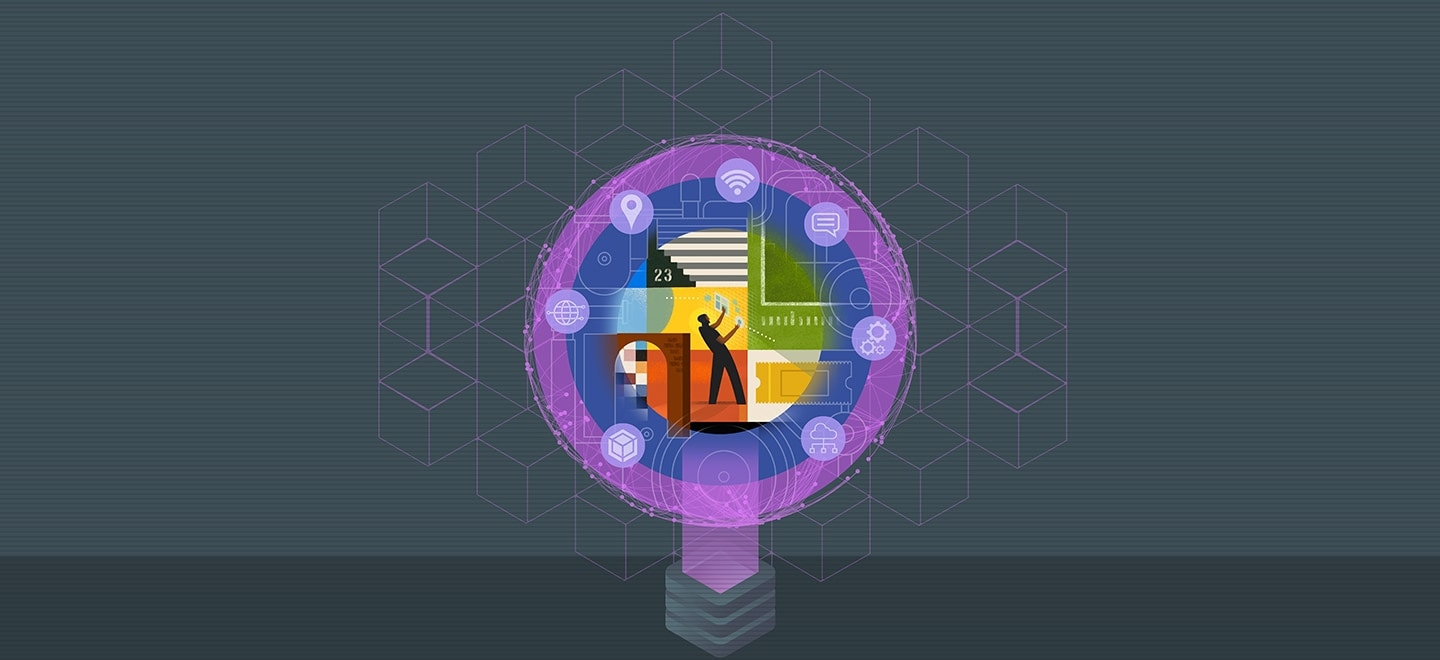Apple Vision Pro: The leap to spatial computing
Note: This is a special 2nd post for this week before our US-based team heads into the July 4th holiday! We’ll pick back up with more field notes from the future on the week of July 10th. In the meantime, check the bottom of the newsletter for a brand new section of other glimpses into the future.
In the keynote address of its recent Worldwide Developers Conference (WWDC), Apple®[i] leaders unveiled an arresting new device: the Vision Pro® headset, its first spatial computer.
The Vision Pro device combines much of the company’s tech progress and innovation to date in order to usher in a new era in headset-enabled, controller-free interaction. Simply focus your eyes on-screen, pinch fingers together to select, and speak audibly to “type” into the headset’s interface.
Though similar headsets have been marketed as “AR” or “VR” for years, Apple presenters entirely avoided the words "virtual reality", "VR”, and “metaverse” in the keynote. Instead, they focused on the term “spatial computing”, marking a shift to the new bedrock technology upon which the Vision Pro device is built. While spatial computing itself is hardly a new term (our team even published a deep dive on spatial tech a few years back), the Vision Pro could turn it into a mainstream idea.
But, what is spatial computing?
Spatial computing is the seamless joining of the physical and digital realms. It offers a 3D canvas for bits and bytes where boundaries dissolve into immersive space. Put another way, it’s a cutting-edge technology applied to an old problem: Human-Computer Interaction (HCI).
The Vision Pro headset’s new spatial computer interface may seem like a giant leap, but HCI progress isn’t random; history has shown iterative, exponential improvements in the simplicity of our interactions with machines. Mainframe computers once required a PhD and a lab coat to operate a cumbersome punch-card interface. These days, we’re accustomed to touch and swipe interfaces ever-present in our pockets or hands. Similarly, advancements in AR/VR are not a paradigm shift, but the next iteration of HCI into simpler interfaces.
“The technologies that power our interaction with machines get more and more complex, but our lived experiences with these technologies get simpler and simpler” — Mike Bechtel, Chief Futurist at Deloitte Consulting
Even though new interfaces require time to onboard and learn, keep in mind: The touch and swipe interface of the iPhone® mobile phone didn’t entirely replace the click and type interface of the personal computer. Spatial computing will likely not entirely replace existing displays either. It will simply reveal new use cases for an optimal interplay between man and machine.
Remember the “shapes in holes game” we used to play as toddlers? We fit the square shape into the square hole, and the triangle shape into the triangle in order to learn critical cognitive and fine motor skills. From the youngest of ages, we learn to interact with our three-dimensional, spatially stimulating environment using touch and feel. Spatial computers take advantage of this by arranging interfaces in a way that our brains and bodies instinctively understand. In other words? The future may be as simple as our diaper days!
Apple has been meticulously laying the groundwork for this shift to spatial computing through stepping stones of strategic investments. In recent years, they developed ultra-portable, spatial audio with AirPods® headphones, improved optical tracking and scanning for facial recognition in their latest iPhone devices, and invented their own power-efficient silicon with M1 and M2 chips.
All these technologies are combined in the Vision Pro headset, which boasts a vivid screen, internal cameras for eye and facial tracking, and an impressive M2 chip. But the device itself may just be the beginning.
Echoing the launch of the first iPhone mobile phone, the full potential of the Vision Pro headset lies in the hands of pioneering developers, who must invent brand new spatial apps to leverage novel capabilities. When the first iPhone device launched in 2007, there was no App Store®[ii] marketplace, just the hardware of the Apple mobile phone and its own suite of productivity-focused software. One year later, the introduction of the App Store marketplace spurred on a new wave of rapid software innovation which became a boon for iPhone device adoption and enthusiasm. Suddenly this pocket-sized device could do everything you had ever imagined: from flashlights, to social networks, to games.
As spatial computing blurs the boundaries between the physical and the digital, the Vision Pro headset could redefine our relationship with the computer yet again.
As pioneering developers adapt their applications to the capabilities of the Vision Pro headset, we are poised to witness an explosion of innovation that rivals the impact of the first iPhone mobile phone. As capabilities and new apps abound, spatial computing could become a silver bullet for a diverse array of industry use cases:
Architects may iteratively design a new beachfront hotel, walking through the campus digitally, perfecting the flow of light through the building, and experiencing designs long before scale models are built.
Engineers may interactively disassemble and reassemble a multitude of complex airplane or automotive engines without having to acquire it or risk damaging expensive equipment.
Students may learn to rely on a spatial computer as a trusted companion, transcending the confines of textbooks, and bringing knowledge to life in vibrant, three-dimensional splendor. For example, biology students may become intrepid explorers, venturing into the intricate complexities of an artery full of blood cells and oxygen.
Even though we’ve just begun, I look forward to seeing such futuristic applications come to life through the Vision Pro headset and other devices yet to be unveiled. The future of digital reality has arrived. It beckons us to explore, create, and unlock the boundless realms of human imagination.
See you in the spatial web,
Other Glimpses of the Future:
Mercedes-Benz builds a bridge between business and technology | Trend Lines
Can AI unlock the secrets of animal communication? | Engadget
How old batteries will help power tomorrow’s EVs | MIT Technology Review
DoD Investing in Wearable Technology That Could Rapidly Predict Disease | NGAUS.org
[i] Field Notes from the Future is an independent publication and has not been authorized, sponsored, or otherwise approved by Apple Inc.
[ii] Air Pods, Apple, App Store, iPhone, and Vision Pro are registered trademarks of Apple Inc.





